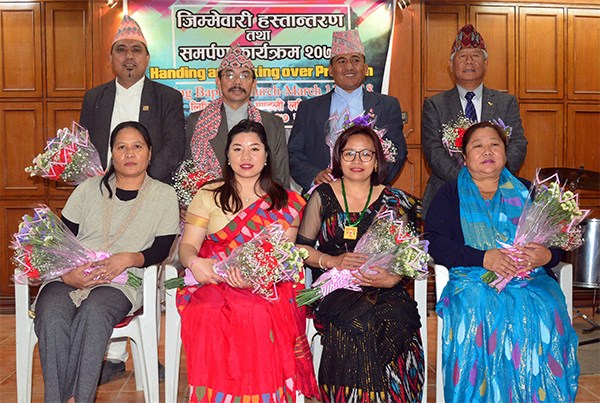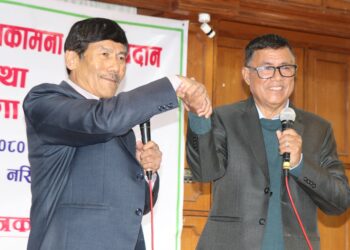Durga P Khanal (Divya)
Introduction
No culture in human history has readily accepted the Christian message. The gospel is seen as contrary to the accepted human cultural norms worldwide from the day Jesus began preaching “Repent: for the kingdom of God is at hand (Mat 4:17). Why do the human cultures resist it? Costas argues, “The gospel seeks to set men and women free from all godless, dehumanizing, alienating, and oppressive forces for the service of God’s kingdom of liberating love, justice, and peace, to enable them to live freely, obediently, and in solidarity for God and humankind (Costas, 2002: 63). The Christian faith’s proposal to transform individuals and their communities through the internalization of biblical ethical values demand a total transformation of ones’ values system and the need for the Word of God to be planted in them. Padilla argues that the word of God needs to become ‘‘flesh” in the people of God to change and shape their culture (Padilla, 1980: 87). Hence, the need for contextualization.
People in the forefront of theological discussions argue that ‘all theology is contextual’ ever since the term was coined by the Theological Education Fund of the World Council of Churches (WCC) in 19972[1]. The Christian faith has strode from the Jewish Jerusalem through Muslim Malaya to the Hindu Himalayas and has gone through many changes in its mode of making sense of faith by confronting countless cultural contexts, any assertion whether ‘all theology is contextual’ needs to be carefully accessed. Even if we agree that all theology is contextual, it can be argued, nevertheless, whether all theology is practical, beneficial and truthful to the very intentions of God?
Whether or not any theology is contextual depends in its very existing context. This short article tries to explore why the Christian theology needs to be contextual so that it no longer termed as impractical, evil and foreign element. It looks to some of the actors that encouraged the contextualization of theologies in the modern day global church. And, finally, it raises some questions in terms of better contextualization of the Christian faith in Nepal’s changing socio-political context.
Contextualizing theologies
Contextual theology refers to the manner in which the church tends to adapt its teachings to the culture in which it finds itself. In the broader sense, “Contextualization is a term describing the “translability” of the universal Christian faith into the forms and symbols of the particular cultures of the world (Conn, 2000:481). It tends to be used in the sense of responding to the gospel in terms of a traditional culture of a local place. It relates to the use of local forms of communication, methods of transmission and personnel.
Also, theology is understood as the knowledge or study about God and his mission. Communicating this mission of God requires a process or a method. According to Yung Hwa theology is that method of communicating Gods’ work on earth. He says, “Theology is born out of mission. The church exists for mission, the mission of God on earth. Mission is the mother of theology” (Hwa, 2014:48). Experiences tell that faith, if not understood and practiced as a part of the cultural realities, it becomes an alien object, unacceptable element and often its practitioners get ostracized. Theology is therefore faith seeking understanding in the context it is practiced. Therefore, missions not only need to use the resources of scripture and tradition to construct theology, but also take seriously the context of human experience. In this sense, theology is the process of interpreting and documenting how Christian faith seeks to understand a particular context where it is being exercised. Matheny argues, “For our faith to have meaning it must be meaningful in a particular historical, cultural and social context” (Matheny, 2011:104). This process of making Christian faith sensible, meaningful and practical in any context it is practice is generally called the contextualization of theologies.
Mission at the centre of contextualisation
The God of the Bible is a missionary God. God’s mission is to redeem his creation through church. “Newbigin maintained that the church can only be properly understood in terms of its missionary calling” (Goheen, 2001:355). Similarly, Matheny argues, “Christian mission must be conducted as the response to the mission dei; the mission of the church is to participate in what God is doing in the world” (Matheny, 2011:21). But the church has not always done a good job in keeping the mission of God at its centre. It has struggled to maintain its mission focus through compromising with the dominant cultural practices of the surrounding society. Let us take, for example the transition of the religious conviction of a tiny persecuted Jewish people of the first century Jerusalem into a dominant religion in Europe after the conversion of the Roman Emperor Constantine in the 4th century. While, many believed this event to be a decisive one in the formation of Christendom, there are others who lament the negative impact of this phenomenon as the church struggled to keep its purity from the worldliness. Once the Christianity became the religion of the dominant peoples of society the very elements of justice, mercy and humility Jesus gave priority in his teachings eroded. Religion became a means for the rich and powerful to gather more in the expense of the poor and it ended up serving the interest of the powerful elites – from the Slave Trade to the Colonialism.
New wave of theological contextualization
As the Christianity began to grow in the Global South, the centre of theology also shifted to Africa, Asia and Latin America from the North. The theology of the North which was developed for the affluent people in a wealthy society failed to connect with the day to day plights of the poor in the poverty stricken society of the South. Matheny rightly observes that “Western scholarship failed to understand and address the issues of the East” (Matheny, 2011: ix). This disconnection between the theology (of the North) and people’s reality in the South has led to more vigorous and fruitful discussion towards contextualization of the Christian theology. The theologians of the South grapple with the dehumanising poverty resulting from inequality and try to interpret the biblical teachings in poverty context. They believed that gospel is not merely a spiritual reality and argued, “If God is relegated to the ‘spiritual’ aspect of human life, and salvation is totally outside the historical realm, it is virtually the salvation of a spiritual nomad” (Heany, 2008: 82).
Many school of theologies thus, emerged, trying to give theology a shape that was relevant to their cultural contexts. The theologians in South America led the way for the formation of liberal theologies. The Christians in India propounded what is now known as a Dalit theology. Many other forms of theologizing took place across the world, all seeking to establish a relevance of theology being promoted in their mission contexts.
For liberationists, theology should be “an energetic, active process which incorporates the contemporary understanding of epistemology, anthropology and history. Through personal participation in the struggle for a new society, theological truth is discerned and formulated in a committed action. It is engagement with a new way of living. It is a fresh understanding of the Christian presence in the world” (Heany, 2008: 76). The attempts to make theology relevant to the people in the Global South did its magic in the North as well. Missionaries and theologians in the Global North such as Jürgen Moltmann, Lesslie Newbigin and others could understand the whole argument put forward by the churches of the South. Consequently, they began re-evaluating their own theology, in the light of the socio-cultural context of the modern West. Jürgen Moltmann was quoted by Goheen as, “Today, the Christian West is waking up to its missionary calling in the world, This has led, not simply to a fresh look at our mission in the world, but to a whole re-evaluation of the nature of the church and its role in God’s redemptive programme” (Goheen, 2001:354).
It can be concluded that the church of the 21st century as in the previous era is in its path to contextualise theology. The Nepali church, which became visible in the latter half of the 20th century, has exhibited some of the outstanding qualities in terms of contextualizing the Christian faith in the context of Nepal. The following lines will examine some of these characteristics.
The church in Nepal
A brief mission work of the Catholic Fathers in the 17th century was cut short as the new king expelled the missionaries together with their 57 native converts when he suspected the Fathers to have connections with the imperialists after he captured Kathmandu (Pandey, 2003:20 and Fricke, 2008, 1). From then on, Nepal was devoid of any resident Christian mission or national presence until the mid-20th century, otherwise an era known as a ‘closed’ period for Christians for approximately 150 years. The second wave of mission work in Nepal started while Nepal was still a ‘closed’ country, among a diaspora community across the eastern border in Darjeeling. (Pandey, 2003: 22; Perry: 2007: 30). With the end of the Rana regime in 1951, Christian missionaries were invited by the government to assist in the development sectors” (Lindell, 1989: 169). This enabled the return of indigenous Christians to Nepal from India who carried out the mission work and established churches in Nepal. Evan Sada observes, “The missionaries working along the border of Nepal in India came to Nepal together with the indigenous Christians to share the Gospel of Christ” (Sada, 2005:8). The church leadership was never assumed by the missionaries but entrusted to the native believers despite their lack of ‘abilities and education’ as compared to them[2]. The missionaries involved in the social side of the mission[3] and accepted the role of subordinate and helped establish locals as church leaders through helping them grow in their understanding of faith and Christian practices. Rongong sounds right when he calls the church in Nepal a ‘colourless church’. “It is neither white nor black because the gospel was preached to Nepalese by their fellow Nepalese”[4].
The absence of colonial imperialism together with the lack of missionary dominance in the formative period of the Nepalese church provided the church in Nepal to be truly a Nepali church. The church had to develop a theology that was relevant to its culture. It had to create a church that looked Nepali in appearance and sounded familiar to the Nepali ears. Nepali pastors laboured and produced a theology which was not alien to the locals. So, the attempts to contextualize the Christian theology in Nepal was planted together with the planting of the local church.
From very early on, the Nepali churches gave importance to what could be developed locally as the indications of Christian theologies. The pastors and lay leaders opted to learn together with their fellow-believes in developing means by which to present theology relevantly. They denied copying the ways of the western missionaries in doing the church. In his book “Early Churches in Nepal (2012), Rongong narrates what Barclay observed to be the driving factors for church growth in Nepal as:
- An unprecedented degree of cooperation between various Christian groups from within the country and beyond
- The prohibition and the reality of persecution prevented nominalism and kept the church strong
- Various short term Bible training centers (in India) for newly converted Nepalese Christians
- Christian Literature, including Nepali Hyman book and radio programmes
- Retired Gurkha servicemen, who had been converted in Indian and British army, returned to their villages and established small Christian communities[5]
These initiatives of the first generation church in Nepal has played very important and lasting roles in presenting the gospel in an indigenised way to the people of Nepal. Nepali Christians read their Bible in Nepali (thanks to William Carey who translated the New Testament in Nepali language in 1821), sing Christian hymns composed using folk musical tunes[6] and dance as their fellow villagers do. The church buildings do not project steeples, nor are they constructed in the manner of the West. One can easily spot that people have respect for their sanctuary; they don’t enter churches with shoes on, sit cross-legged and clap their hands while worshiping God.
New challenges of contextualization
The challenges for contextualization of faith in Nepal, however, are emerging in the present days. With the changes in the socio-political sphere of the country, the church in Nepal is enjoying a relative freedom in terms of its mission work. No more persecution has indirectly meant the influx of missionaries associated with diverse groups and denominations. These missionaries bring a lot of money – to buy followers. But with money they bring peculiar or even questionable practices. There are some missions which encourage the separation of marriages, describe dress code for their followers and even curse the poor. Many of these self-proclaimed missionaries come to Nepal not only with a motive to do ‘God’s mission’ but also to establish their dominance. Of a recent, a competition is observed among the ‘missionaries’ of Asian and other origins that bring all sorts of teachings – ranging from the ‘Mother god of Jesus[7]’ to the ‘son of God’ cults. Their economic force has been of such power that multitudes of Christians from poor economic backgrounds are enrolled into their membership. In fact, the Mother god cult has more than 100 assemblies across Nepal within 10 years of its entry in the country in 2005[8].
Other challenges the Nepali church has to address include the marriage between the spiritual and social emancipation of the Christ followers. Contesting theologies of poverty and of affluence are gripping those economically poor, attracting new messiah of redemption. Modelling faithful stewardship of the natural order/resources is another area the Nepali church has to learn to be relevant amidst increasing experience of the impacts of global warming. The need for meaningful resolution of ever increasing conflicts between the churches demands another sort of contextual attempts. These are the issues the church in Nepal needs to respond in order to make Christian faith meaningful, practical and integral part of the people of Nepal.
Reference
Bevans, Stephen B. (2002). Models of Contextual Theology. Revised and Expanded Edition. Maryknoll, NY: Orbis.
Conn, Harvie M (2000), “Indigenenization,” in Evangelical Dictionary of World Missions, edited by A. Scot Moreau and Harold Wetland. Michgan: Baker Books
Costas, O.E. (2002). Liberating News: A theology of contextual evangelisation. Eugene, OR: Wipf and Stock
Fricke, Tom (2008). Tamang Conversions: Culture, Politics, and the Christian Conversion Narrative in Nepal. Kathamndu: TU
Goheen, M.W. (2001). As the Father has sent me, I am sending you: J.E. Lesslie Newbigin’s missionary ecclesiology. International Review of Mission. XCI
Heany, S.E. (2008). Contextual Theology for Latin America. Milton Keynes, UK: Paternoster
Hwa, Yung (2014). Mangoes or Bananas: The Quest for An Authentic Asian Theology. 2nd Edition. Eugene, OR: Wipf & Stock.
Lindell, Jonathan (1997). Nepal and the Gospel of God. Kathmandu: UMN & Pilgrim Book House.
Matheny, Paul Duane (2011). Contextual theology: the Drama of our Times. Eugene: Pickwick Publication
Padilla, René C. (1980). Hermeneutics & Culture: A Theological Perspective. In Coote, Robert D. & Stott, John (Eds.). Down to Earth: Studies in Christianity & Culture. London: Hodder & Stoughton
Pandey, Simon (2003). Christianity in Nepal. Kathmandu: NCFN
Perry, L. Cindy (1997). Nepali around the World: Emphasizing Nepali Christians of Himalayas. Kathmandu: Ekta books.
Rongong, Rajendra K (2012). Early Churches in Nepal. Kathmandu: Ekta Books.
Sada, Ivan (2005). History of the Church in Nepal in ECS Nepal: The Nepali Way.
[1] In Models of Contextual theology (2002) by Stephen Bevans
[2] Late Tir Bahadur Dewan was the first Nepali pastor. He was converted and trained in Christianity through Nepal Evangelistic Band – NEB which later became International Nepal Fellowship – INF.
[3] United Mission to Nepal – UMN and The Evangelical Alliance Mission-TEAM embraced the education and health sectors but indirectly involved in training Nepalese Christians.
[4] In a speech he delivered to a group of Christian students in 2007, Kathmandu.
[5] Pp 120-22
[6] Most of the Nepali hymns the Christians sing today are composed by Daud Mashi, an illiterate man from the hills of Mid-West Nepal. He was rom a traditional singing caste who converted to Christianity as early as 1960s from the missionaries in India.
[7] Ahan Sahng-hong cult.
[8] In a conversation with Mr. Shyam Thapa. Previously a protestant pastor, Shyam joined Ahan Sahng-hong cult in 2008 and has been one of the key leaders since.

















